Selecting the right PVC banner material is a critical decision that directly affects printing quality, durability, installation efficiency, and the overall performance of visual communications. As outdoor and indoor advertising formats continue to diversify, choosing a material that meets technical, environmental, and aesthetic requirements becomes essential for producing stable and long-lasting large format printing results.
Why Material Selection Matters in Banner Printing
PVC banner material plays a foundational role in modern outdoor banner printing and promotional displays. Its structural stability, print adaptability, and weather resistance make it suitable for a wide range of environments such as building façades, retail fronts, roadside advertising, event backdrops, trade show displays, and indoor signage applications.
Proper selection ensures:
- Stable and high-resolution printing results
- Improved UV resistance and color retention
- Enhanced mechanical strength in wind, rain, and temperature changes
- Smooth installation and reduced risk of curling or tearing
- Cost-effective long-term usage
The selection process requires a technical understanding of material construction and the relationship between printing methods and banner substrates.
Understanding the Construction of PVC Banner Material
Different performance characteristics originate from the base fabric, coating technology, and surface treatments. A well-constructed PVC banner material delivers strength while maintaining flexibility for various installation methods.
Core Material Components
PVC banner material consists mainly of:
- A reinforced base fabric (often polyester mesh or scrim)
- PVC coating layers
- Additional finishing layers depending on application needs
Key Structural Types
The three main categories include laminated, coated, and mesh PVC banner material.
| Material Type | Structural Features | Typical Characteristics | Common Applications |
|---|---|---|---|
| Laminated PVC banner | PVC films laminated to a polyester scrim | Lightweight, economical, suitable for mid-term use | Indoor signage, promotional banners |
| Coated PVC banner | Liquid PVC coated onto base fabric during production | Stronger, smoother, high durability | Outdoor banners, large format printing, long-term displays |
| Mesh PVC banner | Perforated surface with airflow design | Wind-resistant, reduces pressure on installations | Building wraps, scaffolding banners, large outdoor displays |
Understanding these structures helps align material performance with specific project requirements.
Evaluating Surface Finish and Print Compatibility
Surface texture determines ink adhesion, color performance, and final visual effect. Selecting the correct finish can improve clarity, vibrancy, and viewing comfort.
Glossy vs. Matte Surfaces
Different lighting environments require different optical effects.
-
Glossy finish
Enhances color depth and saturation, suitable for small indoor displays and high-impact visuals. -
Matte finish
Eliminates glare and reflection, ideal for outdoor banner printing and large displays.
Smoothness and Ink Absorption
High-quality PVC banner material should provide:
- Consistent ink absorption
- Smooth print surface
- Reduced dot gain in high-resolution printing
This ensures compatibility with solvent, eco-solvent, UV, and latex inks widely used in large format printing.
Durability Factors That Influence Material Selection
Not all environments present the same challenges. Long-term outdoor use requires improved mechanical properties and environmental resistance.
Weather Resistance
Weather-resistant banner materials should maintain performance in:
- UV exposure
- Rain and humidity
- Extreme temperatures
- Wind load conditions
These environmental variables directly affect banner longevity.
Strength and Tear Resistance
Base fabric density and PVC coating thickness affect:
- Tensile strength
- Tear resistance
- Flexibility under pressure
These properties are essential for banners installed in open or high-wind environments.
Fire Resistance and Safety
Some projects require fire-retardant materials to comply with indoor installation standards such as shopping malls, exhibition halls, airports, and public facilities.
Matching PVC Banner Material to Real-World Applications
Identifying the intended application is the fastest way to narrow material choices. Each scenario demands distinct performance characteristics.
Indoor Promotional Displays
Indoor applications prioritize visual quality over durability. Suitable features include:
- Laminated structure
- Lightweight material
- Smooth, matte or glossy options
- High color performance
Outdoor Advertising and Large Format Printing
Outdoor environments require:
- High tensile strength
- Enhanced UV resistance
- Thick coating layers
- Windproof or mesh structures for large installations
Outdoor banner printing benefits from coated PVC materials due to their stability and long-term performance.
Event Backdrops and Stage Decorations
These banners must balance:
- Portability
- High print quality
- Repeated installation capability
Flexible coated materials are commonly preferred.
Building Wraps and High-Wind Installations
Mesh PVC banner material is ideal for:
- High-rise façades
- Construction fences
- Stadium exteriors
The airflow-permeable design reduces wind load while maintaining visual impact.
Choosing the Right Weight and Thickness
Material weight influences installation options, durability, and handling. Common weights range from 240gsm to 510gsm and beyond.
| Weight Range | Recommended Use | Material Behavior |
|---|---|---|
| 240–320gsm | Indoor signage, short-term promotions | Lightweight, easy handling |
| 340–440gsm | Mid-term outdoor use, event banners | Balanced durability and flexibility |
| 450–510gsm | Long-term outdoor advertising | Strong, thick, weather-resistant |
| Mesh materials (various gsm) | High-wind areas, building wraps | Airflow design, reduced stress |
Heavier materials improve durability but may require reinforced installation hardware.
Print Method Compatibility Considerations
PVC banner material must match your printing technology.
Solvent and Eco-Solvent Printing
Suitable for outdoor banners due to:
- High ink adhesion
- Long outdoor life
- Strong color stability
UV Printing
Ideal for:
- High-precision images
- Fast production cycles
- Applications requiring scratch resistance
Latex Printing
Preferred for:
- Indoor displays
- Odor-free advertising
- Smooth color reproduction
Selecting the correct banner surface ensures consistent results across technologies.
Installation Requirements and Material Optimization
Installation conditions influence material choice. Consider:
- Whether the banner will be hung, framed, or stretched
- Wind exposure
- Required finishing options such as grommets, pole pockets, or welded edges
Edge Reinforcement
Coated PVC banner material handles welding more effectively due to its thicker and stronger structure.
Curling Resistance
Materials with stable scrim structures reduce curling and deformation.
A well-matched material minimizes installation time and ensures long-term stability.
Environmental Considerations and Material Sustainability
Modern printing projects increasingly prioritize eco-friendly solutions. When selecting PVC banner material, evaluate:
- Availability of recyclable materials
- Low-odor coatings for indoor spaces
- Reduced-emission printing compatibility
Sustainable material choices help organizations align with environmental goals while maintaining print performance.
How to Evaluate Quality Before Purchasing
Reliable evaluation methods include:
- Checking surface uniformity and texture
- Testing tensile strength and tear resistance
- Inspecting coating thickness
- Verifying print test samples
- Ensuring proper opacity and light-blocking performance
These steps help confirm that the selected PVC banner material meets project requirements.
Recommended Selection Strategy for Different Projects
Below is a practical decision-making chart that aligns project types with material characteristics:
| Project Type | Best Material Choice | Key Reasons |
|---|---|---|
| Indoor advertising | Laminated PVC banner | Lightweight, smooth print quality |
| Outdoor long-term advertising | Coated PVC banner | Durability, UV resistance |
| Large building wraps | Mesh PVC banner | Wind-permeable structure |
| Event backdrops | Coated lightweight banner | Flexibility, high-quality printing |
| Retail promotions | Laminated or coated | Cost-effective and versatile |
Selecting the right category ensures efficient production and stable display performance.
Conclusion: A Strategic Approach to Selecting PVC Banner Material
Choosing the right PVC banner material requires balancing durability, print quality, installation conditions, environmental exposure, and budget. By understanding structural types, surface treatments, print technology compatibility, and project-based requirements, you can ensure long-lasting and high-impact results for any printing scenario.
Whether producing indoor signage, outdoor banner printing, event displays, or large-scale building wraps, the correct material selection ensures consistent performance, clarity, and reliable resistance to environmental challenges. Following the guidelines above will help maximize both visual effectiveness and operational efficiency across all types of display projects.

 English
English CN
CN ES
ES 86-573-88890126
86-573-88890126












